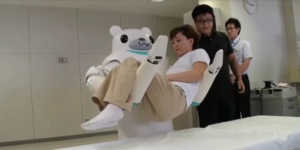Faced with the worst labor shortage in decades, Japanese service companies are finally turning to labor-saving technology, an investment that could lift the sector’s woeful level of productivity and allow them to raise wages.
 While Japan’s manufacturers are renowned for deploying advanced robotics, most domestic-focused services companies fell behind in information technology investment, put off by a stagnant economy, restrictive labor rules and a shrinking domestic market. But as the workforce declines and the nation ages, businesses in areas like nursing and retail have found it harder to attract and keep staff.
While Japan’s manufacturers are renowned for deploying advanced robotics, most domestic-focused services companies fell behind in information technology investment, put off by a stagnant economy, restrictive labor rules and a shrinking domestic market. But as the workforce declines and the nation ages, businesses in areas like nursing and retail have found it harder to attract and keep staff.
Exclusive insights on technology around the world. As Partners Co. Is among companies looking to software for a solution. It plans to spend about 300 million yen ($2.7 million) to install new technology at its 15 nursing homes in and around Tokyo to make life easier for staff and residents. At its sleek new Asheim Nerima Garden home in the west of the city, caregivers can monitor the health of dozens of residents at a time from smartphones, receiving notifications if anyone so much as sits up in bed.
“Once we install this system in all of our nursing homes over the next three years, job turnover will likely decrease and then we’ll be able to hire fewer workers,” President Kenji Uemura said.
Investment in IT by service firms could help provide the elusive wage gains that Prime Minister Shinzo Abe has been seeking for years to revive economic growth. Software spending by non-manufacturers, particularly those in sectors with an acute labor shortage, is picking up “dramatically,” helping to fuel a “long-overdue acceleration” in broader capital spending, said James Malcolm, chief Japan economist at UBS Group AG in Tokyo.
“As capex increases, productivity goes up, wages can go up, and consumption will follow,” Malcolm said. “It’s a key.”
Medium-sized and smaller companies, particularly retailers, are driving the trend, which is accompanied by spending on research and development and employee training, Malcolm said.
Conditions are perhaps the most favorable in years. With exports and domestic demand improving, overall business investment grew 2.4 percent during the second quarter, the most in three years. Six straight quarters of economic expansion have pushed growth to an annualized rate of 4 percent. And a Bank of Japan survey in July showed that small businesses are finding it easier to gain access to capital for investment.
The upshot is that some analysts see a wave of spending on the horizon. Bank of America Merrill Lynch forecast IT investment to rise as much as 9 percent annually in coming years, with the difference in software investment per worker versus the U.S. falling to 5 to 1 by 2020 from about 10 to 1 now.
IT service stocks that may benefit include Fujitsu Ltd., Otsuka Corp., Trend Micro Inc. and NTT Data Corp., according to analysts at Bank of America Merrill Lynch.
Non-manufacturing companies planned 2.4 trillion yen in software investment in the fiscal year ending in March 2018, according to the Bank of Japan’s Tankan survey, released in July. That would be the most since 2009. Retailers plan to spend 146.4 billion yen on software this fiscal year, the most on record for data going back to 1999.
Convenience store operators Lawson Inc., FamilyMart Co. and Seven-Eleven Japan Co. are among those working with Japan’s economy ministry to boost productivity. One of their goals is for all products nationwide, some 100 billion a year, to use radio-frequency identification for price-scanning by 2025.
Lawson is testing shopping baskets that enable customers to scan items as they drop them in, as well as an automated checkout system that would total the cost and bag the items. Customers could shop without ever interacting with human staff.
Yet Japan has a long way to go to catch up with other advanced economies. While its average manufacturing productivity growth was the best among the G7 countries in the two decades to 2014, its overall productivity was still the worst in 2015.
In the services sector, productivity was about half that of the U.S. from 2010 to 2012, according to data from the Japan Productivity Centre. And ingrained employment practices for the nation’s cohorts of “salarymen” mean change may come slowly for many white-collar jobs.
For less desirable occupations, Japan is slowly beginning to tap overseas labour markets. The number of foreign workers in Japan rose 19 percent last year, to top 1 million for the first time. But most are temporary workers, and Japanese leaders have ruled out opening the doors to full-scale immigration, which remains unpopular with the public.
That leaves the country with little choice but to invest in robots, software and automation to maintain its high living standards. Capital spending is the most important factor in Japan’s productivity growth, Goldman Sachs economists wrote in a recent report. If investment doesn’t rise in response to the labor shortage, the country is likely to enter a period of “persistent zero growth” in the 2030s, according to Goldman Sachs.
Izumi Devalier, head of Japan economics at Bank of America Merrill Lynch in Tokyo, said the labor shortage could turn out to be an opportunity, forcing Japanese service-sector companies to finally start investing, and perhaps fueling an economic revival.
“I think of it as the greatest chance Japan will get,” she said.
Kindly follow us on twitter:@AfricanVoice2








